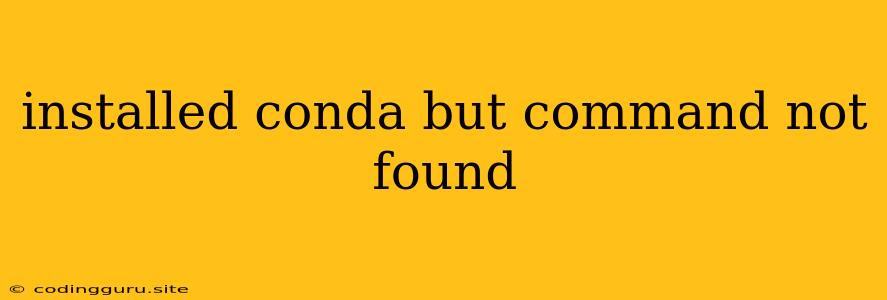"installed conda but command not found" - Why It Happens and How To Fix It
Ah, the dreaded "command not found" error. We've all been there. You've installed Anaconda or Miniconda, the package manager feels like it's working, but when you type conda in your terminal, you're met with that frustrating message. Don't worry! This is a common issue with a few possible causes and solutions.
Why is My conda Command Not Found?
- Environment Variables: The most likely culprit is that your system's environment variables aren't configured to recognize the
condaexecutable. When you install Anaconda or Miniconda, it sets up the environment so you can usecondain your terminal. But sometimes, this configuration gets messed up. - Incorrect Installation Path: If the installation process didn't go as planned, the installer may not have placed the
condaexecutable in the correct location. - Terminal or Shell Issues: You're using a terminal or shell that doesn't have access to the environment variables set up by Anaconda or Miniconda. This is particularly common if you're using a different shell than the one you used during the installation process.
- Incorrect Installation: While less likely, a faulty installation could lead to the
condaexecutable not being properly installed or placed in the correct location.
How To Fix the "command not found" Error
1. Check Your Environment Variables:
-
Windows:
- Open the Control Panel.
- Go to System and Security > System.
- Click on Advanced system settings.
- Select the Environment Variables tab.
- In the "System variables" section, check if there's a variable called "PATH".
- If it exists, double-click on it and make sure the directory containing the
condaexecutable (usuallyC:\ProgramData\Miniconda3orC:\Users\YourUserName\Miniconda3) is included in the list of paths. If not, add it. - If the "PATH" variable doesn't exist, create it.
-
macOS and Linux:
- Open your terminal and run:
echo $PATHThis will show the list of paths your system searches for executables.
- Check if the directory containing the
condaexecutable (usually/usr/local/binor/usr/local/anaconda3/bin) is included in the list. If not, you'll need to add it. - To add the directory permanently, you'll need to modify your shell configuration file. For example:
- Bash: Edit the
.bashrcor.bash_profilefile. - Zsh: Edit the
.zshrcfile. - Add the following line to the end of the file, replacing
/path/to/conda/binwith the actual path to thecondadirectory:
export PATH=$PATH:/path/to/conda/bin - Bash: Edit the
- Restart your terminal or shell after making these changes.
2. Reinstall Anaconda or Miniconda
If the above solution doesn't work, try reinstalling Anaconda or Miniconda. Make sure you're installing it for all users, which will ensure that the environment variables are set up correctly.
3. Check Your Installation Directory
-
Windows:
- Go to the directory where you installed Anaconda or Miniconda.
- Check if there's a folder called "Scripts" or "bin". If not, re-install.
- Inside the Scripts or bin folder, you should find the
condaexecutable.
-
macOS and Linux:
- Open your terminal and navigate to the directory where you installed Anaconda or Miniconda.
- Use the
lscommand to list the contents of the directory. - You should find a folder called "bin" or "Scripts".
- Within that folder, you should find the
condaexecutable.
4. Use a Different Terminal or Shell
- If you're using a terminal or shell other than the one you used during installation, try switching to that original terminal. For example, if you installed using the Anaconda Prompt on Windows, try opening that prompt and running
condaagain.
5. Create a New Environment
- If you're working with multiple environments, try creating a new conda environment:
conda create -n my_new_environment python=3.9- Then, activate the environment:
conda activate my_new_environment- Now, try running
condaagain. This could resolve conflicts that were present in your main environment.
6. Consider a Fresh Install
If you've tried all of the above steps and still can't get conda to work, it might be time for a fresh install of Anaconda or Miniconda. This will ensure that the environment variables are properly set up and that the installation is complete.
Tips
- Always restart your terminal or shell after making changes to your environment variables.
- Run the installer as administrator on Windows to ensure proper permissions.
- Pay attention to the installation instructions for Anaconda or Miniconda. They may provide specific steps for setting up your environment.
- If all else fails, consider reinstalling your operating system. While this is a drastic measure, it will ensure a clean slate and eliminate any potential conflicts that might be preventing
condafrom working.
Conclusion
The "command not found" error is a common issue when working with Anaconda or Miniconda. By understanding the possible causes and following the steps outlined above, you can troubleshoot and fix this problem. Remember, sometimes a simple fix like updating your PATH environment variable can resolve the issue. And always be sure to restart your terminal after making changes to your system. Happy coding!
